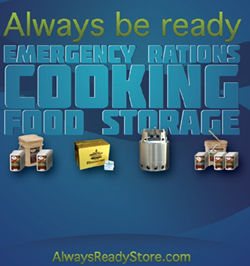Are you ready for the unexpected? When unforeseen circumstances strike, whether it’s a natural disaster or a global pandemic, having a well-stocked pantry can make all the difference.
This guide to essential foods for preparedness will arm you with the knowledge you need to ensure your food supply remains robust and nutritious, no matter what comes your way. We will delve into the world of survival foods, providing you with a comprehensive list of items that are not only long-lasting but also versatile and healthy.
From canned goods to grains, proteins, and even sweets, we’ll uncover the must-have items that should be on every preparedness-minded individual’s shopping list. So buckle up and prepare to transform your pantry into a survivalist’s dream. Let’s embark on this journey towards self-reliance and peace of mind together.
What Are Essential Foods for Preparedness?
When considering essential foods for preparedness, it’s critical to prioritize items that have a long shelf life, require minimal preparation, and provide balanced nutrition. Whole grains such as rice, oats, and quinoa are excellent choices due to their long shelf life and high nutritional value.
Canned goods are another fundamental component of any preparedness pantry. These include fruits, vegetables, beans, and meats, which can last for years without refrigeration. They’re ready to eat and rich in essential nutrients.
Dried beans and legumes are also crucial for their long shelf life and high protein content. They’re lightweight, compact, and can be used in a variety of dishes.
Preserved meats like jerky and canned tuna provide protein and don’t require refrigeration.
Powdered milk is a versatile source of calcium and protein, and it can be used in cooking or rehydrated for direct consumption.
Nuts and seeds are packed with healthy fats, proteins, and fiber, making them an excellent snack choice.
Honey is a natural sweetener that never spoils and can be used in cooking or as a quick energy source.
Spices and seasonings are also vital to store as they can turn bland meals into flavorful dishes.
Remember, always rotate these foods to keep your stock fresh and check expiration dates regularly. A well-stocked pantry can provide peace of mind and ensure you’re ready for any situation.
How to Store Canned Foods?
 Storing canned foods properly is a key aspect of preparedness. The first step is to ensure the cans are not damaged or dented, as this could compromise the food’s safety. Always store cans in a cool, dry place, away from direct sunlight. The ideal temperature is between 50 and 70 degrees Fahrenheit. Avoid storing canned goods near cleaning supplies or chemicals to prevent contamination.
Storing canned foods properly is a key aspect of preparedness. The first step is to ensure the cans are not damaged or dented, as this could compromise the food’s safety. Always store cans in a cool, dry place, away from direct sunlight. The ideal temperature is between 50 and 70 degrees Fahrenheit. Avoid storing canned goods near cleaning supplies or chemicals to prevent contamination.
To maintain the quality of the canned foods, rotate your stock regularly. This means using older cans first and placing newer cans at the back of your storage area. It’s also important to keep an inventory of your canned goods, noting the date of purchase and the ‘best by’ date. This way, you can efficiently manage your stock and avoid wasting food.
When it comes to canned goods, variety is key. Include a range of essential foods such as fruits, vegetables, meats, and beans in your storage. This ensures you have a balanced diet during emergencies.
Remember, canned foods are a reliable and convenient option for long-term storage. They offer a variety of essential nutrients, are easy to store, and have a long shelf life, making them an excellent choice for emergency preparedness.
Best Long Shelf-Life Foods?
When it comes to preparedness, having a stockpile of long shelf-life foods is vital. Canned goods are a popular choice, with options like canned vegetables, fruits, and meats offering both nutrition and long shelf life. These are packed at their peak freshness, ensuring you get the most nutrients even when stored for long periods.
Dry goods such as rice, pasta, and beans are also essential. These staples can last for years when stored properly, making them a must-have in any preparedness plan. Similarly, powdered milk and instant coffee can last for a long time, providing a source of dairy and a comforting beverage when fresh options are unavailable.
Don’t forget about non-perishable protein sources. Canned tuna, chicken, and even SPAM can be stored for several years. These provide essential protein needed for strength and energy during emergencies.
Lastly, consider ready-to-eat meals like MREs (Meals Ready-to-Eat). These military-grade meals are designed to be eaten without cooking, making them a convenient option in times of crisis.
Remember, proper storage is key to prolonging the shelf-life of these foods. Keep them in a cool, dry place, away from direct sunlight. With these foods in your pantry, you’ll be well-prepared for any situation.
Importance of Water in Food Storage?
Water is a crucial element when it comes to food storage for preparedness. It serves multiple purposes, from hydration to cooking and maintaining the freshness of stored foods. Emergency food storage isn’t just about having a stockpile of canned goods, it’s also about ensuring you have a sufficient water supply.
Water is required for rehydrating freeze-dried and dehydrated foods, a popular choice in long-term food storage. Without an adequate water supply, these foods are essentially useless. Furthermore, water plays a vital role in preserving the nutritional value of stored foods, preventing them from drying out and losing their essential nutrients.
In case of emergency situations where access to clean, drinkable water is compromised, having a stored water supply becomes even more critical. It’s recommended to store at least one gallon of water per person per day for both consumption and food preparation.
When planning your food storage, it’s important to keep in mind the space water storage will require. Water barrels, water purification tablets, and water filters are all useful tools to consider.
Remember, food storage preparedness is not just about the foods you store, but also the water you have on hand to support your nutritional needs.
How to Store Dry Foods?
Storing dry foods properly is an essential part of food preparedness. The first step is to ensure that your dry foods are placed in air-tight containers. These containers protect the food from exposure to the elements, pests, and moisture.
Next, consider the location for storage. A cool, dry, and dark place is ideal for preserving the quality of dry foods. This could be a pantry, a dedicated storage room, or even a basement.
Temperature control is another vital aspect of dry food storage. Maintaining a consistent temperature of around 50-70 degrees Fahrenheit can significantly extend the shelf life of your foods.
It’s also important to rotate your stock. Use the oldest items first and replace them with new purchases. This practice, known as First-In, First-Out (FIFO), ensures you’re always consuming the freshest products.
When it comes to storing specific types of dry foods, here are some tips:
- Grains and Beans: These should be stored in sealed containers and kept away from heat and light.
- Dried Fruits and Vegetables: These need to be stored in airtight containers to prevent moisture absorption.
- Spices and Herbs: These should also be stored in airtight containers, but in a cool, dark place to preserve their flavor and potency.
Remember, proper storage of dry foods is a key aspect of preparedness and can ensure you have a reliable food supply during emergencies.
Ideal Conditions for Food Storage?
 Storing food properly is an essential part of preparedness. The ideal conditions for food storage vary depending on the type of food, but there are general guidelines that can be followed.
Storing food properly is an essential part of preparedness. The ideal conditions for food storage vary depending on the type of food, but there are general guidelines that can be followed.
Dry foods, such as rice, pasta, and beans, should be stored in a cool, dry place. These foods are susceptible to moisture and heat, which can lead to spoilage.
Canned goods are a staple in any preparedness plan. They have a long shelf life and can be stored at room temperature. However, they should be kept away from extreme temperatures and direct sunlight.
Frozen foods should be kept at a constant temperature of 0 degrees Fahrenheit or below. It’s important to avoid the “”freeze-thaw”” cycle, which can lead to food spoilage.
Perishable foods, such as fruits and vegetables, should be stored in a refrigerator at a temperature between 34 and 40 degrees Fahrenheit. These foods have a shorter shelf life and should be consumed first.
Water is an often overlooked but essential part of food storage. It should be stored in a cool, dark place and replaced every six months.
Remember, the key to successful food storage is rotation. Consume the oldest items first, and replace them with new ones. This ensures that your food supply remains fresh and safe to eat.
Proper food storage not only ensures that you have a supply of food in case of an emergency, but it also helps to reduce food waste and save money. So, take the time to store your food properly, and you’ll be prepared for whatever comes your way.
How to Rotate Stored Foods?
Proper food rotation is crucial when it comes to emergency food storage. The principle of “”First In, First Out”” or FIFO is often applied. This means consuming the oldest stored foods first.
To implement this, start by marking your food containers with the date of purchase. This can be done using permanent markers or adhesive labels. This way, you can easily identify the oldest items in your storage.
When you buy new supplies, don’t just place them on top of the old ones. Instead, move the older items to the front and place the new ones at the back. This ensures that older foods are used first, preventing them from going bad.
It’s also vital to regularly check your food storage. This allows you to spot any signs of spoilage or infestation early on. If you find any expired or damaged items, remove them immediately to prevent contamination.
Another important aspect of food rotation is diversification. Don’t just store one type of food. Having a variety of items not only provides a balanced diet but also prevents food fatigue.
Remember, the goal of food storage is not just to have food on hand, but to have edible, nutritious food that can sustain you and your family during emergencies. Proper food rotation plays a key role in achieving this.
Can Frozen Foods Be Stored Long Term?
Indeed, certain frozen foods can be stored long term, making them excellent choices for preparedness. However, it’s crucial to consider the type of food and the conditions of storage.
Vegetables and fruits, when properly blanched and frozen, can last up to 12 months. They retain their nutritional value and can be a valuable source of vitamins during times of scarcity. Meats and poultry can also be stored long term, but their quality may start to degrade after 4-6 months.
Frozen meals are another category to consider. While they may not be the healthiest option, they can provide essential calories and are easy to prepare. Most can last up to 8-12 months in the freezer.
On the other hand, dairy products, such as milk and cheese, do not fare well when frozen for extended periods. They can develop a change in texture and flavor.
Storage conditions play a significant role in long-term preservation of frozen foods. A constant temperature of 0°F (-18°C) is recommended to maintain the quality of the food.
In terms of preparedness, it’s also important to consider the risk of power outages. If the freezer’s temperature rises, the food’s shelf life will be significantly reduced. Therefore, having a backup power source or alternative storage method can be beneficial.
Remember, while frozen foods can be stored long term, it’s essential to rotate your stock regularly to ensure you’re consuming the freshest produce. This practice also allows you to assess your inventory and replenish as needed.
So, can frozen foods be stored long term? Yes, but with careful consideration of the type of food and storage conditions.
Conclusion: The Essentials of Food Preparedness
In this post, we’ve explored the crucial aspects of food preparedness, focusing on the essential foods to store for readiness in uncertain times. We’ve delved into what constitutes essential foods for preparedness, understanding that these are foods with a long shelf-life and high nutritional value.
We’ve also discussed the importance of proper storage, from canned and dry foods to long-term frozen food storage. We’ve learned that ideal conditions for food storage are cool, dry, and dark places, and the importance of rotating stored foods to maintain their freshness and nutritional value.
Water, being a vital part of food storage, was also emphasized, as its role extends beyond just hydration to food preparation and sanitation.
As we look towards the future, the importance of food preparedness remains paramount. Trends suggest a growing interest in sustainable and space-efficient food storage solutions.
In conclusion, food preparedness is not just about having food stored away, but having the right foods, stored correctly. The knowledge gained from this post empowers you to make informed decisions regarding your food storage practices. Remember, preparedness is the key to survival in any situation.








0 Comments